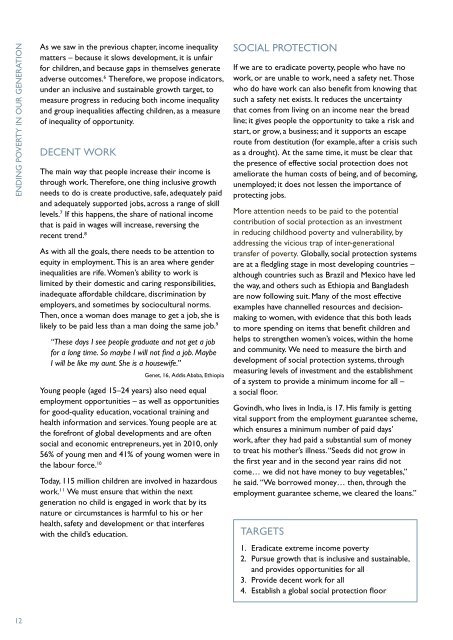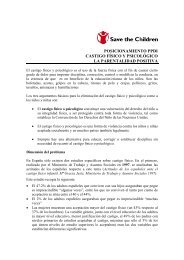ENDING poverty - Save the Children
ENDING poverty - Save the Children
ENDING poverty - Save the Children
You also want an ePaper? Increase the reach of your titles
YUMPU automatically turns print PDFs into web optimized ePapers that Google loves.
<strong>ENDING</strong> POVERTY IN OUR GENERATION<br />
As we saw in <strong>the</strong> previous chapter, income inequality<br />
matters – because it slows development, it is unfair<br />
for children, and because gaps in <strong>the</strong>mselves generate<br />
adverse outcomes. 6 Therefore, we propose indicators,<br />
under an inclusive and sustainable growth target, to<br />
measure progress in reducing both income inequality<br />
and group inequalities affecting children, as a measure<br />
of inequality of opportunity.<br />
DECENT WORK<br />
The main way that people increase <strong>the</strong>ir income is<br />
through work. Therefore, one thing inclusive growth<br />
needs to do is create productive, safe, adequately paid<br />
and adequately supported jobs, across a range of skill<br />
levels. 7 If this happens, <strong>the</strong> share of national income<br />
that is paid in wages will increase, reversing <strong>the</strong><br />
recent trend. 8<br />
As with all <strong>the</strong> goals, <strong>the</strong>re needs to be attention to<br />
equity in employment. This is an area where gender<br />
inequalities are rife. Women’s ability to work is<br />
limited by <strong>the</strong>ir domestic and caring responsibilities,<br />
inadequate affordable childcare, discrimination by<br />
employers, and sometimes by sociocultural norms.<br />
Then, once a woman does manage to get a job, she is<br />
likely to be paid less than a man doing <strong>the</strong> same job. 9<br />
“These days I see people graduate and not get a job<br />
for a long time. So maybe I will not find a job. Maybe<br />
I will be like my aunt. She is a housewife.”<br />
Genet, 16, Addis Ababa, Ethiopia<br />
Young people (aged 15–24 years) also need equal<br />
employment opportunities – as well as opportunities<br />
for good-quality education, vocational training and<br />
health information and services. Young people are at<br />
<strong>the</strong> forefront of global developments and are often<br />
social and economic entrepreneurs, yet in 2010, only<br />
56% of young men and 41% of young women were in<br />
<strong>the</strong> labour force. 10<br />
<br />
work. 11 We must ensure that within <strong>the</strong> next<br />
generation no child is engaged in work that by its<br />
nature or circumstances is harmful to his or her<br />
health, safety and development or that interferes<br />
with <strong>the</strong> child’s education.<br />
SOCIAL PROTECTION<br />
If we are to eradicate <strong>poverty</strong>, people who have no<br />
work, or are unable to work, need a safety net. Those<br />
who do have work can also benefit from knowing that<br />
such a safety net exists. It reduces <strong>the</strong> uncertainty<br />
that comes from living on an income near <strong>the</strong> bread<br />
line; it gives people <strong>the</strong> opportunity to take a risk and<br />
start, or grow, a business; and it supports an escape<br />
route from destitution (for example, after a crisis such<br />
as a drought). At <strong>the</strong> same time, it must be clear that<br />
<strong>the</strong> presence of effective social protection does not<br />
ameliorate <strong>the</strong> human costs of being, and of becoming,<br />
unemployed; it does not lessen <strong>the</strong> importance of<br />
protecting jobs.<br />
More attention needs to be paid to <strong>the</strong> potential<br />
contribution of social protection as an investment<br />
in reducing childhood <strong>poverty</strong> and vulnerability, by<br />
addressing <strong>the</strong> vicious trap of inter-generational<br />
transfer of <strong>poverty</strong>. Globally, social protection systems<br />
are at a fledgling stage in most developing countries –<br />
<br />
<strong>the</strong> way, and o<strong>the</strong>rs such as Ethiopia and Bangladesh<br />
are now following suit. Many of <strong>the</strong> most effective<br />
examples have channelled resources and decisionmaking<br />
to women, with evidence that this both leads<br />
to more spending on items that benefit children and<br />
helps to streng<strong>the</strong>n women’s voices, within <strong>the</strong> home<br />
and community. We need to measure <strong>the</strong> birth and<br />
development of social protection systems, through<br />
measuring levels of investment and <strong>the</strong> establishment<br />
of a system to provide a minimum income for all –<br />
a social floor.<br />
Govindh, who lives in India, is 17. His family is getting<br />
vital support from <strong>the</strong> employment guarantee scheme,<br />
which ensures a minimum number of paid days’<br />
work, after <strong>the</strong>y had paid a substantial sum of money<br />
to treat his mo<strong>the</strong>r’s illness. “Seeds did not grow in<br />
<strong>the</strong> first year and in <strong>the</strong> second year rains did not<br />
come… we did not have money to buy vegetables,”<br />
he said. “We borrowed money… <strong>the</strong>n, through <strong>the</strong><br />
employment guarantee scheme, we cleared <strong>the</strong> loans.”<br />
TARGETS<br />
1. Eradicate extreme income <strong>poverty</strong><br />
2. Pursue growth that is inclusive and sustainable,<br />
and provides opportunities for all<br />
3. Provide decent work for all<br />
4. Establish a global social protection floor<br />
12
















